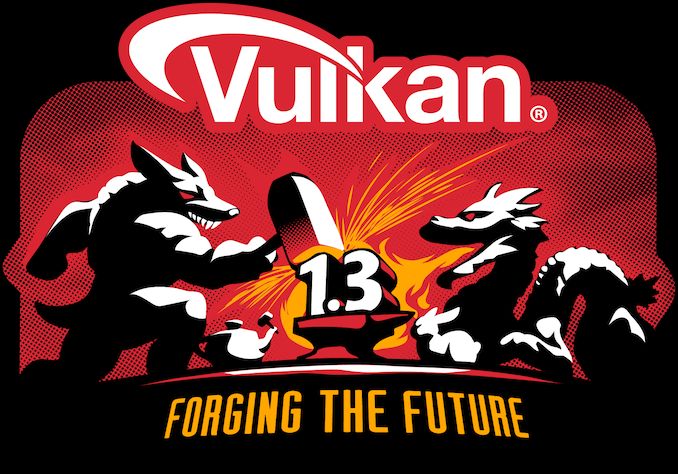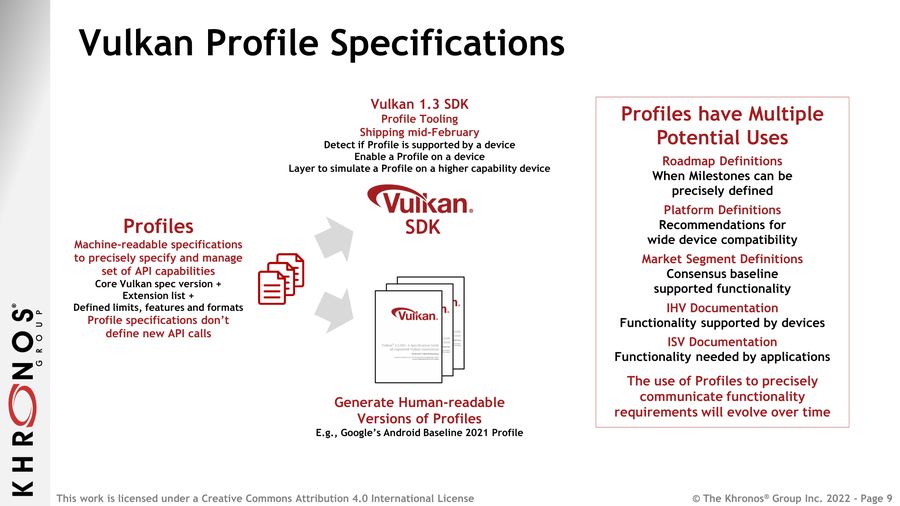
The Khronos Group has released yesterday the specifications of the new Vulkan 1.3 (Vulkan 1.2 specs have been released in 2020).
Vulkan 1.3 mandates widely supported features into the core standard; the Vulkan Roadmap provides visibility into Vulkan’s future requirements for key markets; Profiles streamline development and deployment of portable applications.
Beaverton, OR – January 25, 2022 – Today, The Khronos Group, an open consortium of industry-leading companies creating advanced interoperability standards, announced the latest updates to Vulkan, the cross-platform 3D graphics API and its ecosystem.
– The Vulkan 1.3 specification was released today, incorporating and mandating proven, developer-requested extensions to make that functionality consistently available across all supported platforms.
– The Vulkan Working Group is developing a public roadmap to provide guidance on when and where more advanced Vulkan functionality will be supported. The Vulkan Roadmap 2022 milestone for mid-to-high-end hardware defines features beyond Vulkan 1.3 that will be available starting this year.
– Vulkan profiles will be introduced, with tooling, in the February 2022 Vulkan 1.3 SDK to precisely specify, manage and use sets of API capabilities. Profiles will be used to communicate functionality requirements for roadmaps, markets, platforms, and hardware and software developers.Vulkan 1.3 and Vulkan Roadmap
Vulkan 1.3 incorporates a number of carefully selected extensions requested by the developer community into a new core version of the specification. These include dynamic rendering, additional dynamic state[1][2], an improved synchronization API, and a range of other features (see the Vulkan 1.3 and Roadmap blog post for details). Crucially, unlike previous revisions, no features added to Vulkan 1.3 are optional, ensuring their consistent availability in all implementations of this new API version.As with previous versions of the specification, Vulkan 1.3 is designed to be accelerated on OpenGL ES 3.1-class hardware, enabling the core API to be supported in a wide range of devices and markets. Many Vulkan devices support functionality beyond the core specifications through optional extensions which individual hardware vendors may choose to support—or not. The Vulkan Roadmap aims to consolidate the support for selected extensions to provide a common functionality baseline in key markets.
Vulkan Roadmap 2022 announced today is the first defined milestone in the Vulkan Roadmap. All Vulkan Working Group hardware vendors actively developing mid-to-high-end devices for smartphone, tablet, laptop, console, and desktop platforms are committed to supporting this milestone, starting with several shipping products in 2022. The milestone requires support for Vulkan 1.3 plus a number of extensions the Working Group considers essential for the target market, including descriptor indexing, fragment shader stores and atomics, subgroup support in fragment shaders, independent blending, sample shading, anisotropic filtering, YCbCr sampling, and scalar block layout for buffer resources. Roadmap 2022 also raises minimum values for many hardware limits, including max image and image array dimensions, max subgroup size, and various limits on how many resources can be accessed per shader stage. See the Vulkan 1.3 and Roadmap blog post for more details.
Vulkan Profiles
The new Vulkan profile mechanism enables the precise specification and management of sets of API capabilities. Each profile specifies a core version of Vulkan plus a set of required extensions, with supported limits, features, and formats. Profiles provide a way to precisely communicate functionality requirements and device capabilities between participants in the Vulkan ecosystem to streamline the development and deployment of portable applications.Google has developed and released the Android Baseline 2021 Profile to advertise the set of features beyond Vulkan 1.0 that are supported by a large majority of active devices in the Android ecosystem, including devices that are out of support and do not regularly receive driver updates.
The Vulkan Roadmap 2022 Profile will encode the Vulkan roadmap’s first milestone currently documented in the Vulkan 1.3 specification for release with the Vulkan SDK in mid-February.
Khronos tooling will enable developers to generate their own application-specific feature profiles, easily determine whether a device supports a given profile, and enable the features/extensions in a profile at application startup. A beta version of the tooling will be released in mid-February as part of the Vulkan 1.3 SDK, and will include a machine-readable file format for profile definitions, files defining the profiles released to date, a header-only library, and profile simulation support via the new VK_KHRONOS_LAYER_profiles layer.
This press release is available HERE.
An overview of Vulkan 1.3 and Roadmap 2022 is available HERE.

Vulkan specifications are available HERE:
– Vulkan 1.3 core specifications (1490-page PDF)
Vulkan Version 1.3 promoted the following extensions into the core API (source):
- VK_KHR_copy_commands2 - VK_KHR_dynamic_rendering - VK_KHR_format_feature_flags2 - VK_KHR_maintenance4 - VK_KHR_shader_integer_dot_product - VK_KHR_shader_non_semantic_info - VK_KHR_shader_terminate_invocation - VK_KHR_synchronization2 - VK_KHR_zero_initialize_workgroup_memory - VK_EXT_4444_formats - VK_EXT_extended_dynamic_state - VK_EXT_extended_dynamic_state2 - VK_EXT_image_robustness - VK_EXT_inline_uniform_block - VK_EXT_pipeline_creation_cache_control - VK_EXT_pipeline_creation_feedback - VK_EXT_private_data - VK_EXT_shader_demote_to_helper_invocation - VK_EXT_subgroup_size_control - VK_EXT_texel_buffer_alignment - VK_EXT_texture_compression_astc_hdr - VK_EXT_tooling_info - VK_EXT_ycbcr_2plane_444_formats


NVIDIA has released a beta driver (473.11) with Vulkan 1.3 support. You can download this driver from this page or from this page.
All Vulkan news are available at Vulkan’s homepage.